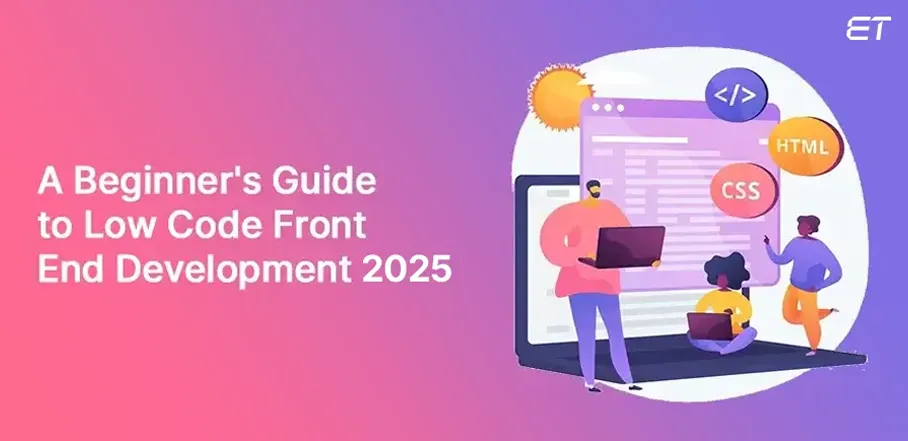
A Must Follow Guide to Low Code Front End Development 2025
The market for open-source low-code platforms generated revenues of almost $22.5 billion in the United States in 2022, and it is expected to generate $187.0 billion by 2030. This blog will shed light on how and why low code front end development is replacing well-liked front end technologies, which you should stop using to save your time and cost.
Every business nowadays needs a digital strategy that guides using digital tools and services to advance organizational objectives. To overcome these issues, “low code development” has become increasingly popular.
Previously, best practices of front end development meant extensive planning, selecting the appropriate front end development tools, libraries, and frameworks, and hiring highly qualified programmers. This requires a lot of time.
With low code technology and the right front end development services, business users can now construct the same application with less than half the work, time, and resources. The open-source low code development platforms let users build robust, adaptable, and scalable applications. While enabling subject matter experts and business users to materialize their objectives, it also facilitates cross-team collaboration by simplifying IT specialists’ duties.
According to experienced front end development companies, low code front end development, compared to traditional development, provides a faster, more accessible, and cost-effective approach. How?
Low Code VS Traditional Development
| Low Code Development | Traditional Development |
| Rapid development with visual interfaces and prebuilt components. | Coding is required from scratch leading to longer development timelines. |
| Minimal Coding expertise needed | Require in-depth programming skills |
| Reduced development cost due to a faster development cycle. | Higher development costs due to longer development cycles and specialized skills. |
| Easier collaboration among non-technical stockholders | Collaboration may be as challenging as technical jargon |
| Limited customization | High customization & flexibility |
Low code is projected to continue to spread as a frequent social and technological phenomenon. Since 2020, it has grown by 30%, bringing in $5.8 billion in 2022.
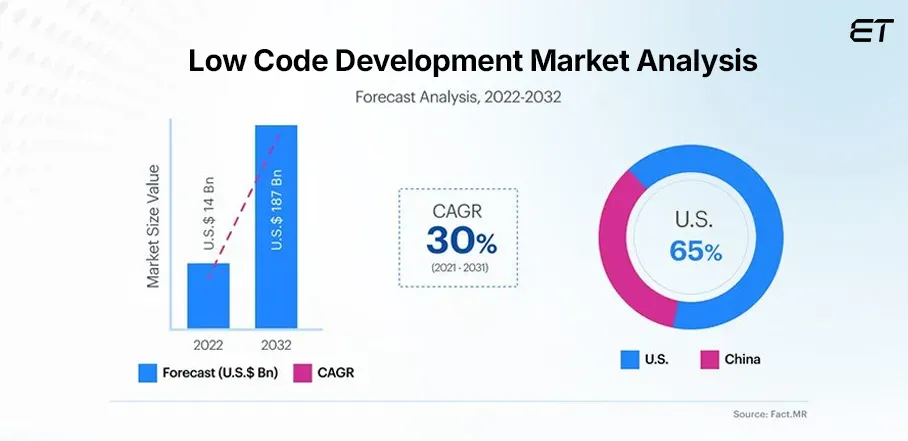
Low code principles and techniques can be applied to a variety of commonplace programming tasks by experienced developers and line of business (LOB) workers who comprehend business concerns. This may free up development teams to concentrate on bigger, trickier tasks.
Let’s understand everything about low code front end development: when, why, and how before deciding if it is the best approach for your ideal projects.
Without further ado, let’s get started!
What is Low Code Front End Development?

Low code, as the name suggests, means that less code needs to be written throughout the development of the application to provide the needed functionality. Low code development is the quick and progressive building of applications, application extensions, and web portals using a simple point-and-click interface. It helps follow the latest web development trends.
Low code front end development is a software development approach that empowers individuals with limited coding expertise to create user interfaces and design visually appealing web applications or software systems. It allows users to build front end components and interfaces using drag-and-drop functionalities, pre-built templates, and visual interfaces, reducing the need for manual coding.
Front end developers can build powerful front ends for web and mobile applications faster by avoiding challenging app development programming languages with open source low code development platforms. Low code front end development also encourages collaboration among business stakeholders, designers, and developers.
However, it’s important to note that low code development may have limitations in terms of customization and flexibility compared to traditional coding approaches. While it offers convenience and speed, complex or highly specialized functionalities may still require custom coding or the integration of external libraries.
Are you all wondering what types of business applications can be created using a low-code platform?
Well, there are countless options! Let’s explore some common ones.
Low Code Front End Development Use Cases
|
Rapid Prototyping
|
Open source low code development allows dedicated teams to create web or mobile application prototypes quickly. It enables stakeholders to visualize and interact with the proposed user interface, gather feedback, and make necessary adjustments before proceeding with full-scale development. |
|
Content Management Systems (CMS)
|
Content-based websites or blogs can benefit by leveraging pre-built templates and components. Content creators can focus on producing and managing content while utilizing low-code platforms to design and maintain the website’s front end. |
|
Data Visualization Dashboards
|
Dashboards that present data analytics or performance metrics often require intuitive and visually appealing interfaces. Low code front end development aids in building interactive and customizable dashboards that help users understand and analyze data effectively. |
|
Legacy System Modernization
|
Many businesses continue to use outdated legacy systems that are incompatible with modern technology. These systems can be modernized using low code platforms by developing new user interfaces, combining them with new software, and enhancing overall functionality. |
|
Customer-Facing Portals
|
Companies often require customer portals or self-service platforms where users can access information, place orders, or interact with services. The open source low code platforms enable the creation of intuitive and user-friendly web portals with customizable interfaces and interactive features. |
|
Internal Business Applications
|
Low code platforms can be used to quickly and effectively build custom web applications. Users may develop applications that automate corporate operations, manage data, and offer insights into essential indicators using prebuilt templates and drag-and-drop components. |
|
Mobile Applications
|
These platforms offer cross-platform capabilities, allowing the low code Android app development or iOS app development easier. Therefore, businesses can create mobile apps without needing separate development teams or extensive coding knowledge. |
|
E-Commerce Development
|
Building e-commerce websites involves designing attractive product listings, shopping carts, and checkout processes. Low code development simplifies the creation of these interfaces, allowing businesses to establish online stores quickly. |
These use cases highlight the versatility of low code development, enabling organizations to accelerate the development of various applications. However, these platforms empower individuals with limited coding experience to actively participate in the software development process. Thus, it is advisable to take the help of expert front end development companies to reduce the flaws and get desired results in less time.
Looking to supercharge your low-code project? Discover how our expert front-end developers can make all the difference.
Types of Low Code Platforms
Here are 6 types of low code platforms generally used.
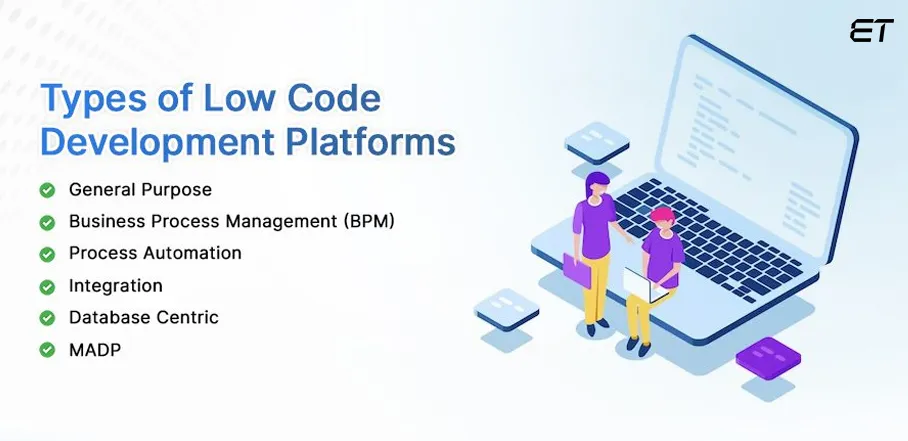
1. General Purpose
These platforms can build almost any kind of application, from mobile apps to business processes. A general-purpose platform enables front end developers to build apps that can be used everywhere and cater to various purposes.
2. Business Process Management (BPM)
These platforms concentrate especially on apps that manage business processes, such as forms, workflows, and system integrations. These low code front end development platforms are frequently used to streamline operations and automate workflows.
3. Process Automation
These platforms focus on automating business processes and workflows. They enable users to design and deploy automated processes without complex coding. They often include features like drag-and-drop workflow builders and integration with existing systems.
4. Integration
Different software programs and systems are integrated using integration platforms to operate in unison. They are frequently used in corporate settings to link various systems and enhance communication and data flow.
5. Database Centric
These platforms are designed to create database-driven applications quickly. They offer visual tools to define data models, create database schemas, and build user interfaces for data entry and retrieval.
6. MADP
Mobile application development platforms (MADP) are designed especially for custom mobile app development. You can build code for one platform (low code Android app development) using these technologies, then port the program to many mobile devices. With capabilities like app previews, device emulators, and integrations with mobile-specific functionalities, they offer tools for creating native or cross-platform mobile apps.
How Does Low Code Strategy Work?

A low code front end development platform is designed to simplify the process of building web or mobile applications by minimizing the need for manual coding. These platforms typically provide visual interfaces, pre-built components, and drag-and-drop functionality, enabling front end developers to create user interfaces (UI) and user experiences (UX) with minimal coding effort.
Low code platforms also include a back-end architecture for handling data, security, and deployment in addition to the visual development environment. This makes it simple for developers to deploy their applications to the cloud or on-premises and connect them to databases, APIs, and other services.
Low code technology abstracts and encapsulates a large portion of the programming expertise typically required to produce software. Similar to constructing a flow chart to address a business problem or activity, they arrange and organize the functional components that are now accessible to form the planned software flow.
Here’s a general overview of how a low code development platform works:
|
Sr. no.
|
Components | Function |
|
1.
|
Visual Interface | The platforms usually offer a visual interface where developers can design the UI of their applications. |
|
2.
|
Pre-built Components | It comes with a library of pre-built UI components that developers can use to construct their applications. |
|
3.
|
Configuration and Customization | Once the desired components are placed on the canvas, developers can customize their appearance and behavior through configuration options provided by these platforms. |
|
4.
|
Data Integration | Many low code platforms offer integration capabilities to connect with data sources, APIs, databases, or other services |
|
5.
|
Testing and Deployment | Once the UI is designed and configured, the built-in testing and debugging capabilities help identify and fix issues services |
Must Follow Low Code Front End Development Principles
Low code development principles are designed to ensure that applications developed are top-quality, scalable, and maintainable. Here are some key principles to simplify and streamline the development process.
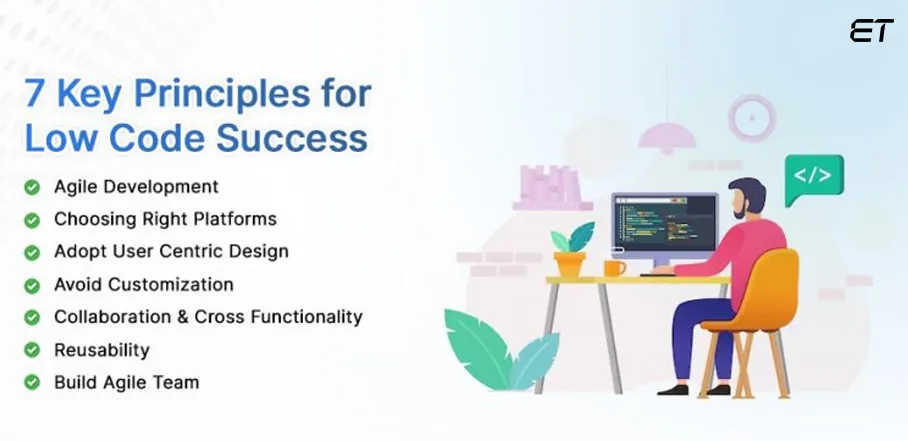
1. Agile Development
Low code platform allows front end development companies to iterate quickly and react to shifting requirements. To facilitate rapid development and deployment, this concept encourages the adoption of agile development approaches like Scrum and Kanban.
2. Choosing Right Platform
Selecting the best low code automation platform is crucial to the success of your project. Without adding complexity, the platform should assist all stakeholders in achieving their objectives.
Discover the secrets of low-code development! Explore which platform—Power apps or Mendix—will supercharge your project. Read our blog to find the perfect fit for your needs!
3. Adopt User Centric Design
Adopting a user-centric approach to design guarantees that goods and services are crafted to satisfy customers’ unique requirements and preferences, improving satisfaction and usability. Throughout the development phase, apply user-centric design thinking techniques to address user problems with desired solutions
4. Avoid Customization
The predefined components that can be put into the workflow give low code its power. Excessive customization can complicate things, make maintenance more difficult, and go against the fundamentals of simplicity and quick creation that low code platforms promote. Therefore, avoiding excessive customization in low code front end development is essential to retain the advantages and efficiency these platforms offer.
5. Collaboration & Cross Functionality
Low code platforms encourage cross-functionality and cooperation among development teams. This helps maintain version control, manage features that allow numerous team members to collaborate simultaneously, and improve communication. Low code software development promotes feedback and teamwork, which enables you to test all hypotheses and identify the ideal solution.
6. Reusability
Low code encourages the reuse of components and logic. Front end developers can create reusable components or templates used across multiple projects or within the same application. This principle promotes consistency, efficiency, and faster development.
7. Build Agile Team
Build a compact, stable, and agile front end development team. Stable and agile to see your project quickly pivot and iterate. Keep it small to utilize the resources effectively.
Find Incredible Features of Low Code Front End Development Platforms
We have covered the top features contributing to efficiency, speed, and ease of development, enabling developers to create applications with reduced manual coding efforts rapidly.
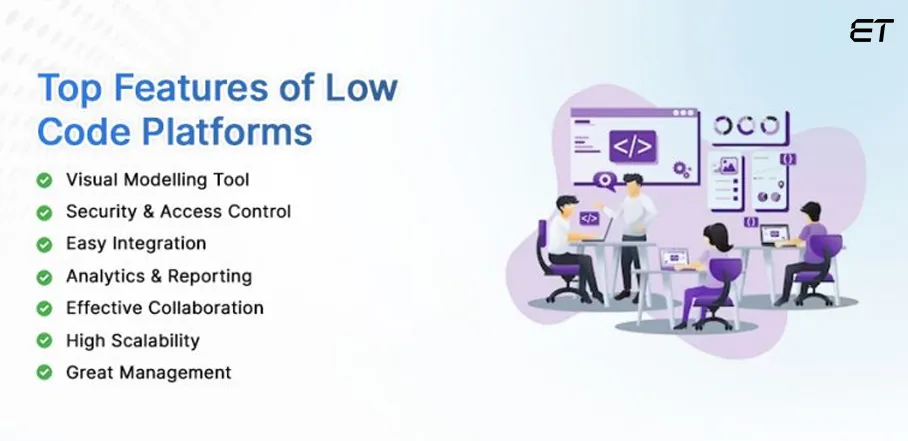
-
Visual Modelling Tool
These platforms provide visual interfaces that allow front end developers to design and configure applications using drag-and-drop components, canvas-based layout editors, and visual workflows.
-
Security & Access Control
They offer features to manage user authentication, authorization, and data security, including role-based access controls, user management, and encryption options.
-
Easy Integration
They often provide tools and connectors to integrate with various data sources, databases, APIs, and services, enabling dedicated developers to access and manipulate data within their applications.
-
Analytics & Reporting
These platforms may offer built-in analytics and reporting features, allowing developers to track application usage, generate reports, and gain insights into user behavior.
-
Effective Collaboration
These platforms often include features for collaboration among team members, allowing multiple developers of a front end development company to work on the same project simultaneously, manage version control, and facilitate communication.
-
High Scalability
Low Code platforms are made to be scalable, enabling applications to expand with changing business requirements. Therefore, using these platforms, enterprises can start small and gradually add additional features and capabilities as and when required.
-
Great Management
Using low code platforms, you may speed up several phases of your app development life cycle, including designing, testing, and more. Users may easily retrieve information about previously generated apps and switch back to earlier versions.
Benefits of Low Code Front End Development for Businesses
Open source low code development offers several benefits that can stand any business ahead of competitors. Here are some of the top benefits.
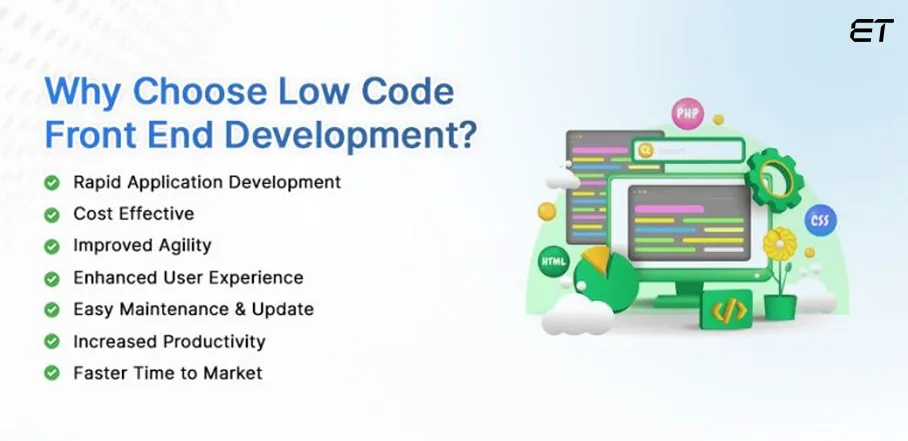
-
Rapid Application Development
Low Code platforms offer prebuilt templates, modules, and other components that may be easily put together to create a usable application intended to speed up the development process. This can drastically cut down on development time and enable enterprises to react swiftly to shifting market trends.
-
Cost Effective
Low code development reduces the need for hiring more personnel, saving money. The streamlined development process, shorter development cycles, and reduced need for extensive coding efforts contribute to overall cost reduction in application development.
-
Improved Agility
With open source low code development, businesses may respond to shifting requirements with greater flexibility and agility. They can respond to customer needs and stay ahead of the competition because of the ease of development and quick iterations.
-
Enhanced User Experience
The open source low code development platforms provide a range of pre-built components and UI/UX elements, enabling developers to create intuitive and visually appealing user interfaces. This focus on user experience results in applications that are more engaging, user-friendly, and aligned with end-user expectations.
-
Easy Maintenance & Update
Low code applications are generally easier to maintain and update. With centralized control, changes and updates can be deployed more efficiently across the application, minimizing disruption and reducing the overall effort required for maintenance.
-
Increased Productivity
Low code platforms streamline development processes by abstracting complex coding tasks and automating repetitive tasks. This allows front end developers to focus on higher-level design and business logic, resulting in increasing productivity and efficiency.
-
Faster Time to Market
Low code application development allows developers to build applications more quickly than conventional software development methods. By utilizing pre-built components and visual tools developers can create apps in a small fraction of the time it would take to write the same code from scratch.
Curious about how top-tier frontend development can transform your projects? Discover the exceptional benefits and innovative solutions we offer. Connect to see how partnering with us can make a difference!
Common Challenges of Low Code Front End Development
Low code software is designed to make it simpler for non-technical individuals to create business applications while cutting down time and cost. But open source low code development, like any software development approach, has its own challenges. Here are some common challenges of open source low code development.

-
Complexity of Integration
Integrating low code front end applications with external systems or APIs can be a challenge. Low code platforms may have limitations when it comes to handling complex data structures, legacy systems, or specific integration requirements. In such cases hire front end developers who will use custom coding or external tools to address such integration complexities.
-
Limited Flexibility
Low code platforms often provide pre-built components and templates, which may limit the flexibility of design customization. Front end Developers may face constraints when trying to achieve highly specific or unique visual designs, as they are bound by the available options provided by the platform.
-
Security Concerns
Since low code platforms sometimes rely on third-party libraries and services, which can introduce security flaws, they could not be as secure as conventional software development techniques. This can be a concern for businesses that work with sensitive data.
-
Limited Use Cases
Open source low code development platforms successfully resolve some commercial programming issues, but not all. It might have trouble with some complex tasks or need so much customization and integration that traditional software development methods and toolsets are preferable.
-
Complex Business Logic
While low-code platforms simplify front-end development, complex business logic requirements may still arise. Implementing intricate workflows, conditional logic, or complex data manipulation may require additional customization or manual coding beyond the platform’s capabilities.
-
Version Control & Collaboration
Managing version control and collaborating with other team members can be challenging within a low code platform. Coordinating updates, merging changes, and maintaining a clean codebase may require additional processes or tools to ensure smooth collaboration.
-
Vendor Lock-in
Using a specific low-code platform may create a level of dependency and vendor lock-in. Switching to a different platform or extending functionality beyond the platform’s capabilities may require significant effort or be challenging due to platform limitations.
-
Debugging & Troubleshooting
Identifying and debugging issues within a low code front end application can be more complex due to the abstraction layers provided by the platform. Debugging tools and techniques may differ from traditional coding approaches, requiring developers to adapt their debugging strategies accordingly.
-
Unoptimized & Insufficient Code
When programming is abstracted into reusable, generic components, the underlying code may become bloated and overly complex for the task at hand. Good handwritten code can solve such coding issues effectively and elegantly.
Popular Low Code Front End Development Platforms in 2025

Low-code platforms are conventional ones that concentrate on the two most crucial elements: designing and developing the front end and quickly adding business logic while providing flexibility for making modifications ready for the market. The top 5 low code front end development tools with their pros and cons are listed below:
1. Mendix
Mendix offers a comprehensive low code platform for front-end development, providing visual modeling, reusable components, and easy integration with external systems. It emphasizes collaboration and allows developers to build responsive web and mobile applications.
| Pros | Cons |
|
|
2. OutSystem

OutSystems is a popular open source low-code development platform that provides extensive front-end development capabilities with a visual interface and drag-and-drop components. It supports responsive design, integrates with various systems, and offers features for collaboration and deployment.
| Pros | Cons |
|
|
3. Microsoft Power Apps
Power Apps, part of the Microsoft Power Platform, offers low-code tools for building front-end applications. It provides a wide range of pre-built UI components and data integration options and supports responsive design.
| Pros | Cons |
|
|
Unlock the full potential of Power Apps! Dive into our top-ranking blog for the ultimate guide and insights you need to master this powerful tool.
4. Kissflow
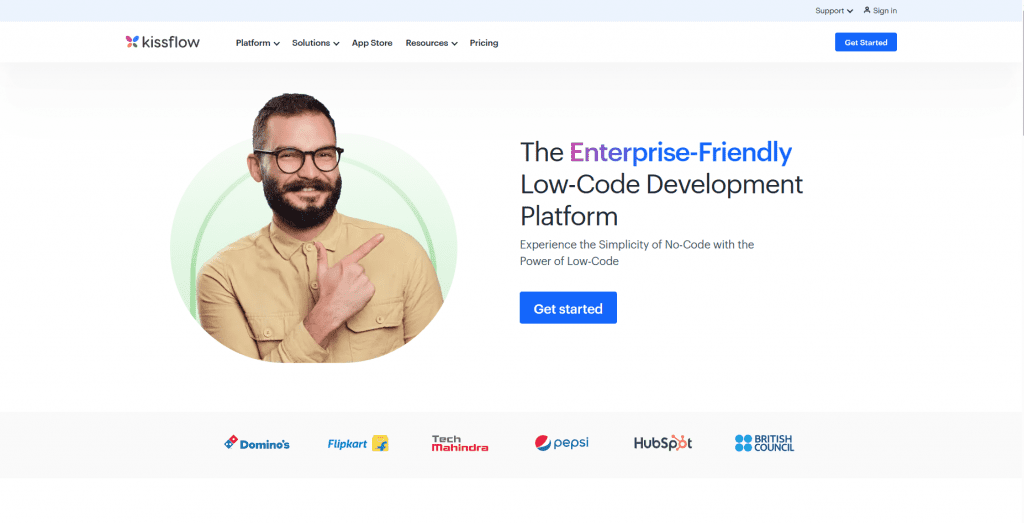
Kissflow is a low-code development platform that provides a vast array of tools and capabilities to develop robust custom web applications. Thanks to its straightforward and user-friendly interface, businesses may rapidly create powerful apps, processes, or case boards that are natively integrated and versatile.
| Pros | Cons |
|
|
5. Salesforce Lightning
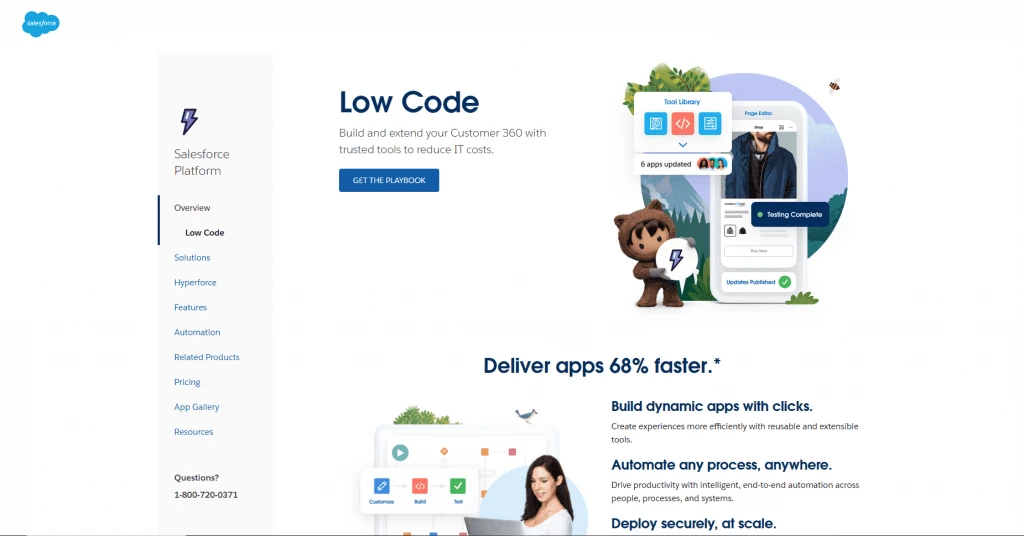
Salesforce Lightning is a low code front end development platform with top-notch features for building custom user interfaces within the Salesforce ecosystem. It provides a drag-and-drop interface and component library and integrates with Salesforce’s CRM functionalities.
| Pros | Cons |
|
|
Key Considerations While Choosing Your Low Code Front End Development Platform
Choosing an open source low code development platform requires careful consideration of various factors. Here are some key points to help you make an informed decision:

-
Integration Capabilities
Check if the platform allows easy integration with external systems and services such as APIs, databases, authentication providers, and third-party tools. Seamless integration capabilities are crucial for robust and functional web application development.
-
Scalability & Performance
Consider the scalability and performance aspects of the low code platform. Evaluate whether it can handle the expected user load and accommodate future growth. Look for platforms that offer optimization features and support for caching, content delivery networks (CDNs), and efficient code generation.
-
Cost & Licensing
Consider the pricing model and licensing terms of the low-code platform. Assess whether it aligns with your budget and offers flexibility as your project scales. Some platforms charge based on usage or the number of users, so evaluate the cost implications accordingly.
-
Ease of Use
One of the primary advantages of low-code platforms is their simplicity. Assess whether the platform is user-friendly by exploring its interface, documentation, and support resources. Look for drag-and-drop features, visual development tools, and intuitive workflows that align with your team’s skill levels.
-
Hosting & DevOps
The platform you choose should support agile development, versioning applications, managing CI/CD pipelines, prioritizing disaster recovery, and other DevOps functionalities.
-
Security & Compliance
Ensure the low code platform adheres to security best practices and industry compliance standards. Look for features like data encryption, role-based access control, and secure authentication mechanisms to protect sensitive user information.
Read more: Top 10 Low Code Development Platforms

Ready to leverage a result-driven low-code strategy? Discover how partnering with our expert developers who grasp your challenges can lead to impactful solutions!
Is Low Code Future of Web Development?
Open source low code development redefines how apps are created, tested, deployed, and monitored in the modern digital era. It enables skilled front end developers, business users, and even non-programmers to create cutting-edge mobility solutions without sacrificing quality.
Considering the COVID-19 pandemic and the fact that businesses worldwide are concentrating on front-end development outsourcing, the use of low-code platforms will surely rise in the future.
Since staff are now remote and unavailable, many firms have had difficulty creating apps, portals, web forms, and automated workflows. With a greater spectrum of IT and business participation, low code front end development lets firms close this gap and build apps for specific business reasons.
According to an analyst firm Gartner, open source low code development accounted for less than 25% of all application development in 2020 but will make up 75% by 2025. Further, as per him, annual revenues for low-code platforms will increase from a little over $9 billion to almost $30 billion within that period.
According to Statista, the global low code development platform market is anticipated to generate enormous revenue of $65 billion in 2027 with a CAGR of 26.1%.
Given the rising demand for enterprise-grade applications, goods, and services, we truly believe that it is the perfect time to expand your technological capabilities and invest in low-code platforms,
To make the most of a low code development platform and create mission-critical applications more quickly and effectively, get in touch with our front end development team.
FAQs
1. What is low end coding?
‘Low-end coding’ is not a valid term. In fact, some people use this term instead of ‘low-code development.’ In simple words, this strategy includes developing software with minimum coding and using drag-and-drop features.
2. Will low code replace traditional coding?
Low code simplifies software development. However, it cannot fully replace conventional programming, as complex or custom digital products can reach their full potential only through traditional coding.
3. What is a significant limitation of low-code front-end development?
Lack of customization is one of the most pivotal limitations of this software development approach. In most cases, you only need to utilize the pre-built templates for building websites or software through low code development.




